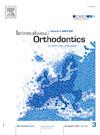Accuracy of combining intraoral and facial scan in a single digital model of an orthodontic patient utilizing corresponding measurements on the model and on real photographs: A prospective cross-sectional study
IF 1.9
Q2 DENTISTRY, ORAL SURGERY & MEDICINE
引用次数: 0
Abstract
Objectives
To validate the accuracy of integration of intraoral scan to the facial scan acquired by the EM3D application, utilising the Blue Sky Plan 4 software, creating a digital model of an orthodontic patient, by comparing the same linear measurements on real photographs and images from the digital model of the patient.
Material and methods
Thirty patients (20 females and 10 males; age range 12–30 years) undergoing orthodontic treatment with fixed appliances were recruited in this prospective cross-sectional study from December 2024 to February 2025. Five facial landmarks were marked on each patient: Tragion right, Cheilion right and left, Subnasale and Pronasale. Intraoral scan and facial scan were performed at the same appointment. Facial scan was conducted using an iPhone 13 Pro with the EM3D face scanning application which utilizes the iPhone's TrueDepth camera technology while the patient was smiling. The STL (Stereolithography) and OBG (Object) files (acquired from intraoral and facial scan respectively) were combined in a digital model using the Blue Sky Plan 4 software. Lateral and frontal photographs of the patient's face, while smiling, were also acquired. Eight linear measurements (Tragion right – bracket #11, Tragion right – incisal #11, Cheilion right – #13, Cheilion left – #13, Subnasale – #11, Subnasale – #21, Pronasale – #11, Pronasale – #21) were digitally performed on the real and digital photographs of the patients using the facial landmarks and certain points on teeth and braces. Paired sample t-test and Wilcoxon signed-rank test were used for statistical analysis.
Results
Significantly statistical difference was detected only in one (Cheilion right – #13) measurement (P = 0.004).
Conclusion
Combining intraoral and facial scan using a special software provides a clinically useful digital model of an orthodontic patient for diagnosis, treatment planning and outcome assessment.
利用模型和真实照片上的相应测量,在正畸患者的单个数字模型中结合口内和面部扫描的准确性:一项前瞻性横断面研究
目的利用Blue Sky Plan 4软件创建正畸患者的数字模型,通过比较来自患者数字模型的真实照片和图像的相同线性测量值,验证EM3D应用程序获得的口腔内扫描与面部扫描整合的准确性。材料与方法30例患者(女性20例,男性10例;在这项前瞻性横断面研究中,从2024年12月至2025年2月招募了年龄在12-30岁之间接受固定矫治器正畸治疗的患者。在每个患者身上标记5个面部标志:右鼻梁、左鼻梁、鼻下和鼻前。口腔内扫描和面部扫描在同一时间进行。面部扫描是在患者微笑时使用带有EM3D面部扫描应用程序的iPhone 13 Pro进行的,该应用程序利用了iPhone的TrueDepth相机技术。使用Blue Sky Plan 4软件将STL (Stereolithography)和OBG (Object)文件(分别从口腔内和面部扫描获取)合并到一个数字模型中。研究人员还获取了患者微笑时的侧面和正面照片。使用面部标志和牙齿和牙套上的某些点,对患者的真实照片和数字照片进行了八次线性测量(右耳部-支架#11,右耳部-切牙#11,右耳部- 13,左耳部- 13,鼻下- 11,鼻下- 21,Pronasale - 11, Pronasale - 21)。采用配对样本t检验和Wilcoxon符号秩检验进行统计分析。结果只有一次(Cheilion right - #13)测量结果有显著统计学差异(P = 0.004)。结论口腔内扫描和面部扫描结合使用的特殊软件为正畸患者的诊断、治疗计划和结果评估提供了临床有用的数字模型。
本文章由计算机程序翻译,如有差异,请以英文原文为准。
求助全文
约1分钟内获得全文
求助全文
来源期刊

International Orthodontics
DENTISTRY, ORAL SURGERY & MEDICINE-
CiteScore
2.50
自引率
13.30%
发文量
71
审稿时长
26 days
期刊介绍:
Une revue de référence dans le domaine de orthodontie et des disciplines frontières Your reference in dentofacial orthopedics International Orthodontics adresse aux orthodontistes, aux dentistes, aux stomatologistes, aux chirurgiens maxillo-faciaux et aux plasticiens de la face, ainsi quà leurs assistant(e)s. International Orthodontics is addressed to orthodontists, dentists, stomatologists, maxillofacial surgeons and facial plastic surgeons, as well as their assistants.
 求助内容:
求助内容: 应助结果提醒方式:
应助结果提醒方式:


